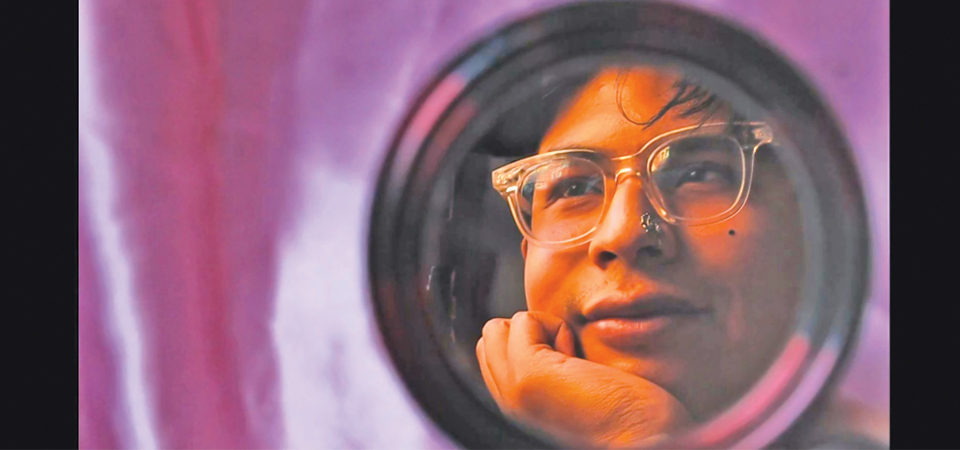An acceptance of self and admission of vulnerability

By Aashish Mishra
Kathmandu, Dec. 12: One of the winners of the Toni Hagen Foundation Documentary Grant of 2021, Ankit Manandhar Khadgi’s ‘I wanted to be like Madhuri Dixit’ is a statement and admission of vulnerability. The very first scene in the movie features Ankit crying and sharing to the world that he feels hurt; hurt by the comments he has received his whole life about the perceived femininity of his behaviour, particularly his love for dancing.
And from there, the movie takes life as a critique of the gender stereotypes our society has so rigidly defined. Ankit, as he shares in the film, has been told throughout his life by many different people that he is not allowed to like dancing. Why? Because he is a man and men, in our society, do not dance – at least not like Ankit does, not like Madhuri Dixit does.
Dance, at its core, is just the rhythmic movement of the body. It is a form of expression just like speaking or writing. But our society, for whatever reason, finds it incompatible with its notion of masculinity and hence, deems it unacceptable for people it wants to make masculine – males. By highlighting this, ‘I wanted to be like Madhuri Dixit’ also shows how so-called masculine and feminine traits are arbitrary attributes defined by random contexts rather than characteristics carrying concrete meanings.
This is illustrated by a conversation Ankit has with his mother in the film. Ankit has dyed his hands with henna and his mother is angry at him for it. She admonishes him for doing something that “only girls do” and asks him if he is a gay. In that context, she also finds the red shorts Ankit is wearing “girly” but is unable to respond when Ankit reveals that the shorts belong to her husband (his father).
But this arbitrariness does not make the forced gender compartmentalisation inflicted by society any less tragic. Ankit has been told by so many people so many times for so long that men don’t dance – that HE SHOULD NOT DANCE – that somewhere down the line, without even realising, he accepted and internalised it. He started to believe that dancing was something wrong which he needed to suppress. That is why the title is in the past tense. Ankit WANTED to be like Madhuri Dixit, but he does not now. He has pushed that part of himself out.
The movie presents somewhat of a happy tone. Ankit has now accepted himself, regardless of whether anyone else has. He is now re-learning to dance and is regaining the confidence to dance in front of others, just like he did in his childhood. But it will take time until he fully recovers the parts of himself that he has lost. Years of trauma cannot be undone in a few months.
‘I wanted to be like Madhuri Dixit’ certainly delves into larger themes but it is not primarily about them. It does not seek to break barriers and preach change. It is a personal package of the 23-year-old Ankit’s journey to self-love and self-acceptance. While there are certainly larger messages to take away, the movie itself does not make a grandstand play. It is simply a portion of Ankit that he has put to screen. He neither makes any claims for others nor does he speak on behalf of anybody. He only shares his story and makes himself vulnerable to the world.
‘I wanted to be like Madhuri Dixit’ was screened on the second day of the Kathmandu International Mountain Film Festival (KIMFF) on December 10 at the Film Development Board, Gopi Krishna Marga, Kathmandu.
Film: I wanted to be like Madhuri Dixit
Length: 20 minutes
Director: Ankit Manandhar Khadgi
Director of Photography: Aashruti Tripathy
Colourist: Safal Karki
Sound Engineer: Ukesh Pariyar
(Disclosure: Aashish Mishra and Ankit Manandhar Khadgi were classmates for four years at the Kathmandu University School of Arts.)
Recent News

Do not make expressions casting dout on election: EC
14 Apr, 2022
CM Bhatta says may New Year 2079 BS inspire positive thinking
14 Apr, 2022
Three new cases, 44 recoveries in 24 hours
14 Apr, 2022
689 climbers of 84 teams so far acquire permits for climbing various peaks this spring season
14 Apr, 2022
How the rising cost of living crisis is impacting Nepal
14 Apr, 2022
US military confirms an interstellar meteor collided with Earth
14 Apr, 2022
Valneva Covid vaccine approved for use in UK
14 Apr, 2022
Chair Prachanda highlights need of unity among Maoist, Communist forces
14 Apr, 2022
Ranbir Kapoor and Alia Bhatt: Bollywood toasts star couple on wedding
14 Apr, 2022
President Bhandari confers decorations (Photo Feature)
14 Apr, 2022









